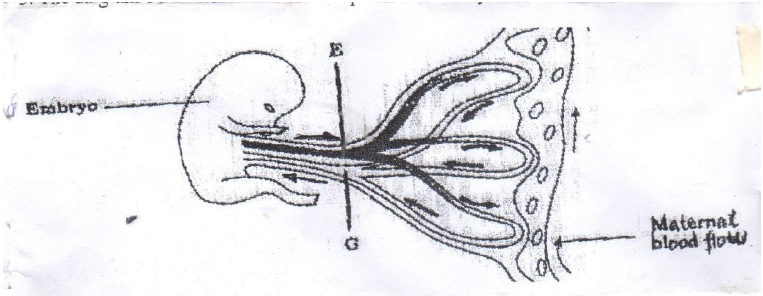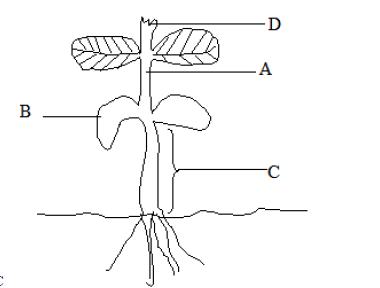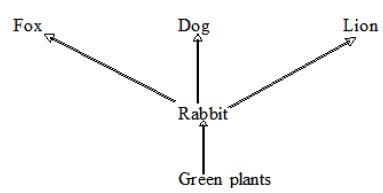Increase in size of stomatal aperture increases transpiration rate; and decrease in stomatal aperture decreases transpiration rate; because a larger stomatal aperture leads to an increased surface area over which transpiration occurs.
Kavungya answered the question on June 14, 2019 at 13:30
- The graph below shows the changes in transpiration rate and the width of the stomatal aperture in Zea mays (maize) over a 24-hour period.
a) What...(Solved)
The graph below shows the changes in transpiration rate and the width of the stomatal aperture in Zea mays (maize) over a 24-hour period.

a) What is meant by the term transpiration?
b) Account for the rate of transpiration between
i)3am and 5am
ii)6am -12 noon
iii)1.00 pm -9.00 pm
Date posted: June 14, 2019. Answers (1)
- State the reasons why glucose level should be maintained constant.(Solved)
State the reasons why glucose level should be maintained constant.
Date posted: June 14, 2019. Answers (1)
- Name one example of a characteristic in man that is transmitted by multiple alleles.(Solved)
Name one example of a characteristic in man that is transmitted by multiple alleles.
Date posted: June 14, 2019. Answers (1)
- State the importance of crossing over in the study of genetics(Solved)
State the importance of crossing over in the study of genetics
Date posted: June 14, 2019. Answers (1)
- Give 2 advantages of cross-pollination over self-pollination.(Solved)
Give 2 advantages of cross-pollination over self-pollination.
Date posted: June 14, 2019. Answers (1)
- Suggest the biological significance of each of the following
i) Development of the pollen tube in fertilization in plants.
ii) Fusion of petals to form funnel-shaped corolla...(Solved)
Suggest the biological significance of each of the following
i) Development of the pollen tube in fertilization in plants.
ii) Fusion of petals to form funnel-shaped corolla tube in certain
flowers.
Date posted: June 14, 2019. Answers (1)
- The diagram below shows exchange of materials between embryo’s bloodstreams and mother’s blood stream(i) Give the names of the parts labelled E and GEG(ii) Name...(Solved)
The diagram below shows exchange of materials between embryo’s bloodstreams and mother’s blood stream

(i) Give the names of the parts labelled E and G
E
G
(ii) Name one substance that is in high concentration in E
(iii) In which organ does this kind of exchange shown occur?
Date posted: June 14, 2019. Answers (1)
- Give the functions of muscles in the alimentary canal(Solved)
Give the functions of muscles in the alimentary canal.
Date posted: June 4, 2019. Answers (1)
- When storing a pair of bar magnets, it is advisable to put a keeper at each end.
a) Draw a diagram in the space below to...(Solved)
When storing a pair of bar magnets, it is advisable to put a keeper at each end.
a) Draw a diagram in the space below to show the above arrangement and label the poles of each magnet.
b) Explain briefly how the above arrangement can minimize the loss of magnetism in the bar magnets.
Date posted: May 29, 2019. Answers (1)
- How is the dry mass of a leaf determined?(Solved)
How is the dry mass of a leaf determined?
Date posted: May 29, 2019. Answers (1)
- Explain why a green leaf is normally tested for the presence of starch instead of glucose.(Solved)
Explain why a green leaf is normally tested for the presence of starch instead of glucose.
Date posted: May 29, 2019. Answers (1)
- In a physiological experiment, starch, protein, diastase and sodium chloride (common salt) were added
to water and put inside a visking tubing. The visking tubing was...(Solved)
In a physiological experiment, starch, protein, diastase and sodium chloride (common salt) were added
to water and put inside a visking tubing. The visking tubing was then placed in a water bath maintained at a temperature between 350C and 400C. The set-up was as shown in the diagram below.

The following observations were made after the procedures indicated.

(a) Name the process by which salt moved into the water in the beaker from the visking tubing.
(b) (i) Name the food substance responsible for the brown colour observed after one hour both in the beaker and visking tubing when solutions were boiled with Benedict’s solution.
(ii) Account for the observation in b(i) above.
(c) (i) Name the food substance tested with sodium hydroxide followed by copper sulphate solutions.
(ii) Account for the absence of the food substance named in c(i) above in the beaker after1 hour.
(d) After one hour, the visking tubing was firm. State the term used to describe this state.
Date posted: May 29, 2019. Answers (1)
- The diagram below represents a section through the mammalian ear. Study it and answer the questions that follow.
(a) Name the structures labelled H and J....(Solved)
The diagram below represents a section through the mammalian ear. Study it and answer the questions that follow.

(a) Name the structures labelled H and J.
(b) State how the structures labelled H, M and N are adapted to their functions. H,M,N.
(c) State what would happen if the structure labelled K was completely damaged?.
(d) Name the fluid contained in structure N.
(e) Apart from hearing, state the other role performed by the human ear.
Date posted: May 29, 2019. Answers (1)
- The figure below shows a germinating seedling.
(a) Name the parts labelled. A,B C
(b) Give three important environmental conditions that are necessary for seed germination...(Solved)
The figure below shows a germinating seedling.

(a) Name the parts labelled. A,B C
(b) Give three important environmental conditions that are necessary for seed germination and state why they are important.
(c) The part labelled D was removed from the above seedling three months later. After a few days the plant became bushy with several lateral branches.
(i) What is this phenomenon called?
(ii) Why did the removal of the stem tip result in a shorter plant with bushy growth?
Date posted: May 29, 2019. Answers (1)
- The diagram below shows part of a food relationship in an ecosystem.
(a) Name the food relationship above.
(b) How many trophic levels are shown in...(Solved)
The diagram below shows part of a food relationship in an ecosystem.

(a) Name the food relationship above.
(b) How many trophic levels are shown in the diagram above.
(c) Name one primary consumer in the food relationship above.
(d) State the main source of energy in the ecosystem.
Date posted: May 29, 2019. Answers (1)
- Explain the absence of fibrinogen in urine yet it is present in blood plasma.(Solved)
Explain the absence of fibrinogen in urine yet it is present in blood plasma.
Date posted: May 29, 2019. Answers (1)
- When corpus luteum breaks down prematurely during pregnancy, miscarriage is likely to result. Explain.(Solved)
When corpus luteum breaks down prematurely during pregnancy, miscarriage is likely to result. Explain.
Date posted: May 29, 2019. Answers (1)
- Name one region in higher plants where cells actively undergo mitosis.(Solved)
Name one region in higher plants where cells actively undergo mitosis.
Date posted: May 29, 2019. Answers (1)
- The diagram below represents some stages in mitosis.
Name the stages represented by the diagrams labelled A, B and C.(Solved)
The diagram below represents some stages in mitosis.

Name the stages represented by the diagrams labelled A, B and C.
Date posted: May 29, 2019. Answers (1)
- What name is given to a cell that contains one member of each pair of chromosomes?(Solved)
What name is given to a cell that contains one member of each pair of chromosomes?
Date posted: May 29, 2019. Answers (1)